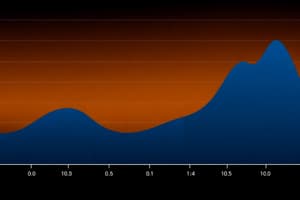Podcast
Questions and Answers
In the first detection example, which process(es) can be marked as completed without leading to a deadlock?
In the first detection example, which process(es) can be marked as completed without leading to a deadlock?
- P3 and P4
- P4 only (correct)
- None of the processes can be marked
- P1 and P2
What is the purpose of the Banker's Algorithm?
What is the purpose of the Banker's Algorithm?
- To resolve deadlocks by terminating processes
- To prevent deadlocks from occurring in the first place
- To detect deadlocks after they have occurred
- To identify safe and unsafe states in resource allocation (correct)
In the second detection example, what is the maximum number of processes that can be granted their requested resources without leading to a deadlock?
In the second detection example, what is the maximum number of processes that can be granted their requested resources without leading to a deadlock?
- 3
- 1
- 2 (correct)
- 4
What is the purpose of the Resource Allocation Graph (RAG)?
What is the purpose of the Resource Allocation Graph (RAG)?
In a safe state, what is true about the sequence of processes that can be executed?
In a safe state, what is true about the sequence of processes that can be executed?
What is a necessary condition for a deadlock to occur?
What is a necessary condition for a deadlock to occur?
What is the purpose of the Banker's Algorithm?
What is the purpose of the Banker's Algorithm?
In the context of the Banker's Algorithm, what is a safe state?
In the context of the Banker's Algorithm, what is a safe state?
What is the purpose of the resource allocation vector (R) in the Banker's Algorithm?
What is the purpose of the resource allocation vector (R) in the Banker's Algorithm?
In a resource allocation graph, what does a cycle represent?
In a resource allocation graph, what does a cycle represent?
What is the purpose of the resource request vector (V) in the Banker's Algorithm?
What is the purpose of the resource request vector (V) in the Banker's Algorithm?
What is the primary cause of the deadlock described in the text?
What is the primary cause of the deadlock described in the text?
How can deadlocks be dealt with in the system?
How can deadlocks be dealt with in the system?
In the Banker's Algorithm, when is a resource request granted?
In the Banker's Algorithm, when is a resource request granted?
In the resource allocation graph described in the text, what do the directed edges from a process to a resource represent?
In the resource allocation graph described in the text, what do the directed edges from a process to a resource represent?
What is the relationship between the presence of a cycle in the resource allocation graph and the existence of a deadlock?
What is the relationship between the presence of a cycle in the resource allocation graph and the existence of a deadlock?
What is the purpose of the Banker's algorithm mentioned in the text?
What is the purpose of the Banker's algorithm mentioned in the text?
Flashcards
Deadlock prevention
Deadlock prevention
Techniques used to avoid deadlock situations in resource allocation by designing systems to prevent the occurrence of necessary deadlock conditions.
Banker's Algorithm
Banker's Algorithm
A resource allocation algorithm designed to avoid deadlocks by ensuring a safe allocation of resources.
Safe State (Banker's Algorithm)
Safe State (Banker's Algorithm)
A state in which there exists a sequence of resource allocations that allow all processes to complete.
Resource Allocation Graph (RAG)
Resource Allocation Graph (RAG)
Signup and view all the flashcards
Cycle in RAG
Cycle in RAG
Signup and view all the flashcards
Resource Request Vector
Resource Request Vector
Signup and view all the flashcards
Resource Allocation Vector
Resource Allocation Vector
Signup and view all the flashcards
Deadlock
Deadlock
Signup and view all the flashcards
Safe Allocation
Safe Allocation
Signup and view all the flashcards
Unsafe State
Unsafe State
Signup and view all the flashcards
Process Completion Sequence
Process Completion Sequence
Signup and view all the flashcards
Directed edge in RAG
Directed edge in RAG
Signup and view all the flashcards
Deadlock Detection
Deadlock Detection
Signup and view all the flashcards
Deadlock Resolution
Deadlock Resolution
Signup and view all the flashcards
Design Error
Design Error
Signup and view all the flashcards
Study Notes
Resource Allocation and Deadlocks
- A system consists of four processes (P1, P2, P3, P4) and three resources (A, B, C).
- Allocation and request matrices are used to track the allocation of resources to processes.
Deadlock Detection Example 1
- P1 is holding resource A, P2 is holding resource B, and P3 is holding resource C.
- P4 is not holding any resources and is waiting for resource A.
- Since P4 is not holding any resources, it is not deadlocked.
Deadlock Detection Example 2
- P1, P2, P3, P4, and P5 are processes that request resources A, B, and C.
- A deadlock occurs if P1, P2, P3, P4, and P5 cannot be marked (i.e., executed) due to unavailability of resources.
Concurrency and Deadlocks
- A deadlock occurs when a set of processes are blocked, each waiting for another process in the set to release a resource.
- A system is in a safe state if there exists a sequence of resource allocations that allows all processes to run to completion.
Resource Allocation Graphs
- A resource-allocation graph consists of vertices (processes and resources) and edges (requests and assignments).
- A cycle in the graph indicates a potential deadlock.
- If the graph contains no cycles, no process in the system is deadlocked.
Studying That Suits You
Use AI to generate personalized quizzes and flashcards to suit your learning preferences.




